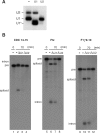U1-independent pre-mRNA splicing contributes to the regulation of alternative splicing
- PMID: 19190090
- PMCID: PMC2665233
- DOI: 10.1093/nar/gkp050
U1-independent pre-mRNA splicing contributes to the regulation of alternative splicing
Abstract
U1 snRNP plays a crucial role in the 5' splice site recognition during splicing. Here we report the first example of naturally occurring U1-independent U2-type splicing in humans. The U1 components were not included in the pre-spliceosomal E complex formed on the human F1gamma (hF1gamma) intron 9 in vitro. Moreover, hF1gamma intron 9 was efficiently spliced even in U1-disrupted Xenopus oocytes as well as in U1-inactivated HeLa nuclear extracts. Finally, hF1gamma exon 9 skipping induced by an alternative splicing regulator Fox-1 was impaired when intron 9 was changed to the U1-dependent one. Our results suggest that U1-independent splicing contributes to the regulation of alternative splicing of a class of pre-mRNAs.
Figures





Similar articles
-
Tissue-specific splicing regulator Fox-1 induces exon skipping by interfering E complex formation on the downstream intron of human F1gamma gene.Nucleic Acids Res. 2007;35(16):5303-11. doi: 10.1093/nar/gkm569. Epub 2007 Aug 7. Nucleic Acids Res. 2007. PMID: 17686786 Free PMC article.
-
Genome-wide RNA-binding analysis of the trypanosome U1 snRNP proteins U1C and U1-70K reveals cis/trans-spliceosomal network.Nucleic Acids Res. 2014 Jun;42(10):6603-15. doi: 10.1093/nar/gku286. Epub 2014 Apr 19. Nucleic Acids Res. 2014. PMID: 24748659 Free PMC article.
-
The transition in spliceosome assembly from complex E to complex A purges surplus U1 snRNPs from alternative splice sites.Nucleic Acids Res. 2012 Aug;40(14):6850-62. doi: 10.1093/nar/gks322. Epub 2012 Apr 13. Nucleic Acids Res. 2012. PMID: 22505580 Free PMC article.
-
Principles and correction of 5'-splice site selection.RNA Biol. 2022 Jan;19(1):943-960. doi: 10.1080/15476286.2022.2100971. RNA Biol. 2022. PMID: 35866748 Free PMC article. Review.
-
Role and mechanism of U1-independent pre-mRNA splicing in the regulation of alternative splicing.RNA Biol. 2009 Sep-Oct;6(4):395-8. doi: 10.4161/rna.6.4.9318. Epub 2009 Sep 21. RNA Biol. 2009. PMID: 19667760 Review.
Cited by
-
U1 snRNP Telescripting: Suppression of Premature Transcription Termination in Introns as a New Layer of Gene Regulation.Cold Spring Harb Perspect Biol. 2019 Feb 1;11(2):a032235. doi: 10.1101/cshperspect.a032235. Cold Spring Harb Perspect Biol. 2019. PMID: 30709878 Free PMC article. Review.
-
U1 snRNA interactions with deep intronic sequences regulate splicing of multiple exons of spinal muscular atrophy genes.Front Neurosci. 2024 Jul 12;18:1412893. doi: 10.3389/fnins.2024.1412893. eCollection 2024. Front Neurosci. 2024. PMID: 39086841 Free PMC article.
-
Pick one, but be quick: 5' splice sites and the problems of too many choices.Genes Dev. 2013 Jan 15;27(2):129-44. doi: 10.1101/gad.209759.112. Genes Dev. 2013. PMID: 23348838 Free PMC article. Review.
-
Dramatically reduced spliceosome in Cyanidioschyzon merolae.Proc Natl Acad Sci U S A. 2015 Mar 17;112(11):E1191-200. doi: 10.1073/pnas.1416879112. Epub 2015 Mar 2. Proc Natl Acad Sci U S A. 2015. PMID: 25733880 Free PMC article.
-
Mechanisms of activation and repression by the alternative splicing factors RBFOX1/2.RNA. 2012 Feb;18(2):274-83. doi: 10.1261/rna.030486.111. Epub 2011 Dec 19. RNA. 2012. PMID: 22184459 Free PMC article.
References
-
- Graveley BR. Alternative splicing: increasing diversity in the proteomic world. Trends Genet. 2001;17:100–107. - PubMed
-
- Maniatis T, Tasic B. Alternative pre-mRNA splicing and proteome expansion in metazoans. Nature. 2002;418:236–243. - PubMed
-
- Black DL. Mechanisms of alternative pre-messenger RNA splicing. Annu. Rev. Biochem. 2003;72:291–336. - PubMed
-
- Ben-Dov C, Hartmann B, Lundgren J, Valcarcel J. Genome-wide analysis of alternative pre-mRNA splicing. J. Biol. Chem. 2008;283:1229–1233. - PubMed
-
- Das R, Zhou Z, Reed R. Functional association of U2 snRNP with the ATP-independent spliceosomal complex E. Mol. Cell. 2000;5:779–787. - PubMed

